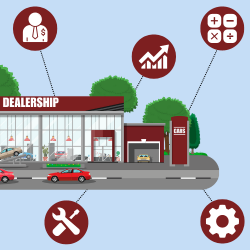The Anatomy of Reynolds’ Dealer Management System (DMS)
Class is in session, and today, we’re talking about anatomy – of our dealer management system (DMS), that is.
Running a car dealership involves juggling countless tasks, from managing inventory to closing sales and keeping customers happy – which is where the DMS comes in. Think of the DMS as a living, breathing organism. Each component plays a crucial role, much like parts of the human body.
Let’s dive into a few key components of the DMS and learn how they keep dealerships healthy.
Reporting and Analytics: The Brain
Just as the brain processes information and makes decisions, the reporting and analytics component of a DMS serves as the intelligence hub. The component gathers data from every department, analyzes trends, and provides insights that drive strategic decisions across the dealership. With comprehensive reports and analytics, management can identify strengths, pinpoint weaknesses, and adapt to market changes.
- Customizable Reports: Generate customized reports to meet business needs and objectives.
- Performance Dashboards: Visualize key performance indicators (KPIs) in real-time, enabling quick and informed decisions.
- Trend Analysis: Forecast demand and optimize operations using historical data.
Finance and Insurance: The Heart
The finance and insurance (F&I) module pumps revenue and ensures the dealership’s vitality, much like the heart. It facilitates loan processing, insurance sales, and warranty management, driving the dealership’s profitability. By accurately managing these processes, F&I ensures the financial pulse of the dealership remains strong and steady.
- Payment Processing: Handle all types of payments seamlessly, from cash to financing.
- Compliance: Protect against potential compliance issues and legal ramifications by implementing digital safeguards.
- Financial Reporting: Generate financial statements, balance sheets, and profit and loss reports to monitor the dealership’s financial well-being.
Sales Management: The Face
The sales component of a DMS acts as the face, directly interacting with customers and facilitating vehicle sales. It manages customer relationships, tracks leads, and processes sales transactions. By providing sales teams with the tools they need to close deals efficiently, this component ensures that the dealership’s influence continues to grow.
- Lead Management: Track and manage sales leads, from initial contact to final sale, ensuring no opportunity is missed.
- Deal Desking Tools: Structure deals that are beneficial for both the dealership and the customer. By analyzing various financing options and trade-in values, sales reps can present the most attractive offers.
- Customer Profiles: Maintain detailed profiles of customers, including purchase history, service records, and communication preferences.
Service Management: The Hands
As the “do-ers” of the body, the hands perform tasks and interact with the environment, providing essential services. Similarly, service management handles maintenance and repairs, ensuring that vehicles are in top condition and customers receive excellent care, leading to loyalty and repeat business.
- Service Scheduling: Schedule service appointments, track technician availability, and manage work orders effortlessly.
- Repair Orders: Create and manage repair orders, including parts used, labor hours, and service history.
- Customer Notifications: Keep customers in the loop with automated service reminders, status updates, and follow-ups.
Parts Management: The Circulatory System
Just as the circulatory system distributes blood, oxygen, and nutrients, parts management keeps track of every vehicle and part, ensuring everything is where it needs to be. It’s the control center that helps the dealership respond swiftly to customer needs, avoid overstocking, and reduce costs.
- Vehicle Tracking: Know exactly where each car is – whether it’s on the lot, in transit, or out for a test drive.
- Distribution and Supply: Keep track of parts so technicians never run out during a crucial repair.
- Pricing and Valuation: Manage pricing, including discounts and promotions, and track the depreciation and valuation of used vehicles based on market trends.
The DMS is much more than a simple software tool – it’s the lifeblood of a thriving dealership. By optimizing operations, enhancing decision-making, and providing exceptional customer experiences, a DMS ultimately ensures that a dealership remains agile, responsive, and ahead of the curve in a competitive market.
Ready to contribute to the vital systems that keep car dealerships running smoothly? Explore opportunities with Reynolds on our Careers site.

















